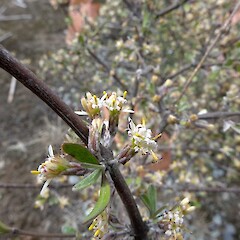Olearia adenocarpa
Common name
Canterbury Plains tree daisy
Synonyms
None
Family
Asteraceae
Flora category
Vascular – Native
Endemic taxon
Yes
Endemic genus
No
Endemic family
No
Structural class
Trees & Shrubs - Dicotyledons
Chromosome number
2n = 108
Current conservation status
The conservation status of all known New Zealand vascular plant taxa at the rank of species and below were reassessed in 2017 using the New Zealand Threat Classification System (NZTCS) – more information about this can be found on the NZTCS website. This report includes a statistical summary and brief notes on changes since 2012 and replaces all previous NZTCS lists for vascular plants.
Please note, threat classifications are often suggested by authors when publications fall between NZTCS assessment periods – an interim threat classification status has not been assessed by the NZTCS panel.
- Conservation status of New Zealand indigenous vascular plants, 2017 . 2018. Peter J. de Lange, Jeremy R. Rolfe, John W. Barkla, Shannel P. Courtney, Paul D. Champion, Leon R. Perrie, Sarah M. Beadel, Kerry A. Ford, Ilse Breitwieser, Ines Schönberger, Rowan Hindmarsh-Walls, Peter B. Heenan and Kate Ladley. Department of Conservation. Source: NZTCS and licensed by DOC for reuse under the Creative Commons Attribution 4.0 International licence.
2017 | Threatened – Nationally Critical | Qualifiers: CD, RF
Previous conservation statuses
2012 | Threatened – Nationally Critical | Qualifiers: CD, De, RF
2009 | Threatened – Nationally Critical | Qualifiers: CD, De, RF
2004 | Threatened – Nationally Critical
Brief description
Rare shrub to 1.5m tall with many upright thin twigs arising from trailing branches and bearing clusters of oval dark green leaves that are bright white on the underside and inhabiting the Canterbury Plains. Flowers small, outer surface hairy (lens needed). Fruit dry, with mostly blob-tipped hairs (lens needed).
Distribution
Endemic. South Island, Canterbury Plains. Known from the vicinity of Christchurch (West Melton), Rakaia Island, and Te Pirita.
Habitat
A lowland species of recently deposited alluvial gravels and sands.
Detailed description
Openly branched, trailing deciduous to semi-deciduous shrub 1.2–1.5 m tall, up to 1.5 m diameter. Branches originating from near or below ground level, widely spreading usually spreading to decumbent, sometimes upright; sometimes rhizomatous. Leaves 3–14 × 2–4 mm, narrowly obovate to broadly obovate or oval, opposite or in fascicles on brachyblasts, upper surfaces light green, grey–green to brown–green with a silvery sheen, undersides uniformly silvery white, base attenuate to cuneate, apex obtuse with a small red to red-brown apiculus. Capitula 1–6 per brachyblast. Pedicels 1.2–4.0 mm long, densely covered with appressed hairs. Involucral bracts 18–22, 4–5-seriate, outer surfaces hairy. Florets 8–12, white. Achenes 2.0–2.5 mm long, light brown, sparsely to moderately covered in sessile glandular hairs.
Similar taxa
Perhaps most closely allied to O. odorata Petrie, from which it can be distinguished by its smaller size.
Flowering
January - February
Flower colours
White
Fruiting
February - March
Propagation technique
Easily grown from semi hardwood and hardwood cuttings and fresh seed.
Threats
Severely threatened by browsing animals, habitat loss/modification, and weed invasion. Fenced plants are vulnerable to overtopping by pasture grasses.
Etymology
olearia: Named after Johann Gottfried Olearius, a 17th-century German scholar, writer of hymns and author of Specimen Florae Hallensis
Previously recorded as Olearia aff. odorata (CHR 386084; Canterbury Plains) in de Lange et al. 2004; Threatened and uncommon plants of New Zealand. New Zealand Journal of Botany 42: 45-76.
Attribution
Fact Sheet prepared for the NZPCN by P.J. de Lange (14 April 2006). Description by P.B Heenan (adapted from Heenan & Molloy (2004) and subsequently published in de Lange et al. (2010).
References and further reading
de Lange, P.J.; Heenan, P.B.; Norton, D.A.; Rolfe, J.R. and Sawyer, J.W.D. 2010: Threatened Plants of New Zealand. Canterbury University Press, Christchurch.
Heenan, P.B. and Molloy, B.P.J. 2004: Taxonomy, ecology and conservation of Olearia adenocarpa (Asteraceae), a new species from braided riverbeds in Canterbury, New Zealand. New Zealand Journal of Botany 42(1): 21-36.
NZPCN Fact Sheet citation
Please cite as: de Lange, P.J. (Year at time of access): Olearia adenocarpa Fact Sheet (content continuously updated). New Zealand Plant Conservation Network. https://www.nzpcn.org.nz/flora/species/olearia-adenocarpa/ (Date website was queried)










